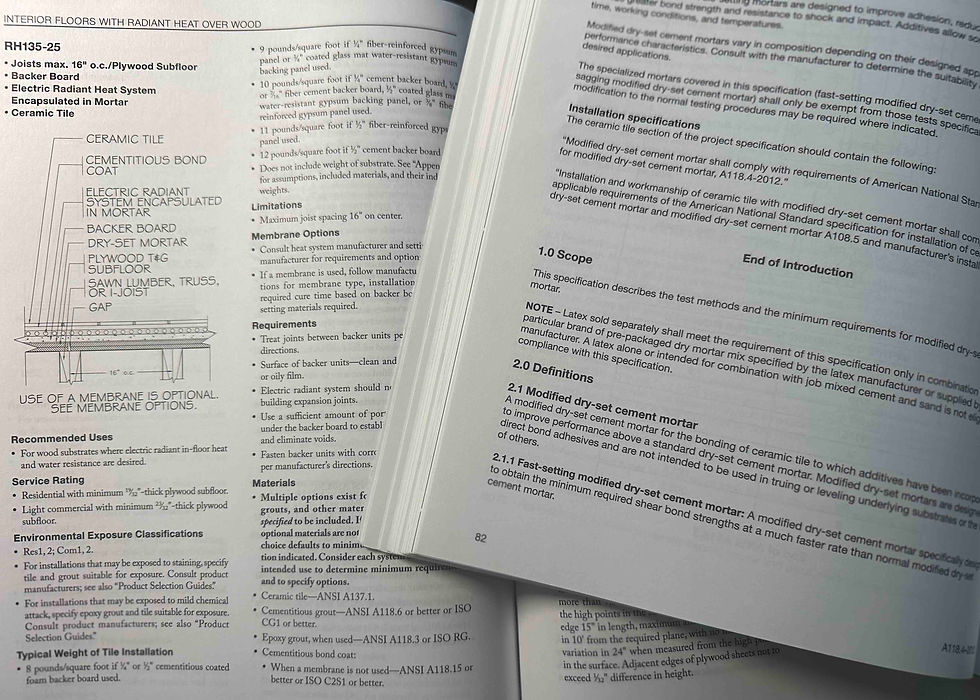TCNA, ANSI, and the NTCA publications. Using tile installation publications, who are they for, and how are they used?
- Michael Weaver

- Sep 22
- 3 min read
The tile industry has three very good publications that provide guidelines, methods & standards, as well as reference material in regards to tile installation. They are used by architects, designers, installers, manufacturers, and attorneys. These are not the only publications, but they can be looked at as the foundation to understand the majority of tile installations in North America.
The publication that is most widely used is the TCNA Handbook. This publication provides a set of guidelines for just about every imaginable assembly. This book contains drawings for all of the assemblies, and provides literature detailing the specific assemblies recommended uses, service ratings, environmental classification, limitations, options, requirements, and much more! The reason that I stated above that the TCNA Handbook is the most widely used of the three publications, is because a lot of information can be gathered from it, and an extensive industry knowledge is not required to make sense of it. Installers often refer to it to get a quick idea of how an assembly should look. The fact of the matter is, it is only one half of what makes a tile project successful.
The ANSI A108, A118, & A136.1 publication contains the methods and standards that must be used in concert with the TCNA guidelines. What are the different types of dry adhesive mortars used in a thin-set application? This book tells you. This is important because if you use the TCNA guidelines and find the assembly that is right for you it may state that it requires A118.15 mortar. If you look in the ANSI standards you will see that A118.15 is improved modified dry set mortar. Now when the installer goes to a distributor to pick up thin-set mortar for his chosen assembly he knows that he must look for A118.15 designated on on the bag. This goes for wallboard, waterproofing, grout, etc. ANSI also has publications specific to ceramic tile A137.1, Gauged porcelain panels A137.3; A108.19; A108.20, glass tile A137.2 and more. The main ANSI book is separated into three sections. A108 provides installation standards, A118 provides material standards A136.1 provides standards on the installation of ceramic tile with organic adhesive.

The NTCA Reference Manual is a publication meant to compliment the TCNA Handbook and ANSI Standards. While the first two books provide the correct guidelines, methods, and standards, the NTCA Reference Manual identifies problems, their causes, and preventable measures. For instance lets say using tile installation publications as a contractor you have a job coming up, and as you look over the plans, you can see that the light source that will be installed above is very close to the wall where you will be installing tile. The flatness of the wall becomes critical, and the tile selection must be taken into consideration. Some tile can cast shadows whether the substrate is irregular or if the tile has warpage. The wall tile may have looked absolutely fine if the light source was two feet away from the wall, but if the light source is eight inches away, the prep work must be perfect, and the tile must cooperate. In the reference manual there are pages dedicated to critical lighting and wall washing effects. A sample letter is provided so the contractor has a way to propose to homeowners and general contractors options for the best course of action. This manual has a lot to do with staying ahead of potential problems, but all how to deal with problems that already occurred.
If after an installation you find discoloration on the grout it might be efflorescence or latex migration. This manual informs you on how to identify what you're dealing with and how to prevent and even cure it. Over 300 pages of problem solving is found in this book. This book is automatically yours when you become a member of the NTCA.
There is a lot of information between all of the available publications. I purchased my first copies of TCNA and ANSI in 2001. The books must be 10 times the size they were back then.

Comments